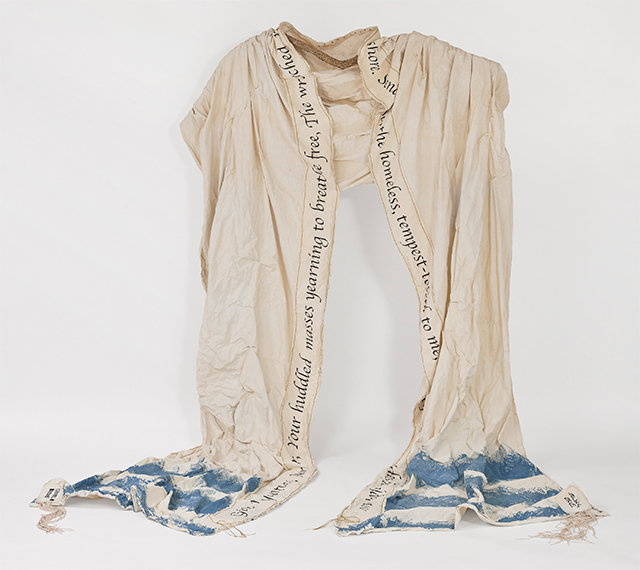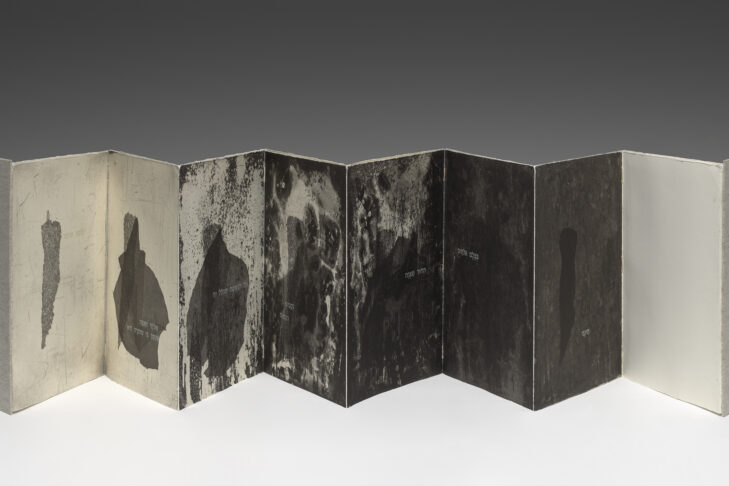Deborah Feinstein, chair of Hebrew College’s arts initiative, has curated the college’s centennial art exhibit—titled “Remember. Renew. Reimagine.”—which celebrates Jewish learning through an artistic lens. In keeping with the college’s Torah-centric curriculum, Feinstein has interspersed artwork from the college’s permanent collection with contemporary artists who responded to her invitation to contribute work to the exhibit.
Feinstein told JewishBoston that she and five judges selected 31 pieces to pay tribute to the college’s diverse art collection, bearing in mind how they “interrelate and connect to Hebrew College.” As a curator and exhibiting artist, her goal is to present images that relate to text, ritual objects and the Jewish values the Torah inspires.
Feinstein said the works of art in the exhibit come together as a “memory corner that encompasses the themes of ‘Remember, Renew and Reimagine.’ They form the basis of unique interpretations of sacred texts that function as Midrash.” As Feinstein walked me through the exhibit, she pointed out that this grouping of art acknowledged the visual learning that is integral to Hebrew College’s curriculum. Feinstein said that as a visual learner, she often responds to texts and literature with images rather than words.

The exhibit fittingly begins with works that conjure the idea to “Remember.” Among the first pieces on display are Torah breastplates, a yad and an atarah, the decorative piece of a prayer shawl that encircles the neck. All of them are from the college’s permanent collection. Contemporary artists Sandra Mayo and Caron Tabb show pieces that evoke the Torah and its role in their lives as immigrants and Jewish women.
Mayo’s piece, “Sense of Safety,” incorporates remnants of a Torah cover that her grandfather brought from Turkey to Argentina. Mayo imprints the century-old disintegrating scraps of fabric in her piece, harkening back to when she longed to touch the cover in synagogue as a girl. She writes, “Growing up, I used the excuse of ‘visiting my father’ to sneak into the men’s section while the Torah was out during prayers; imaging a three-generation reunion at temple.” The piece also evokes her history as an immigrant to the United States.
Tabb has created a striking tallit in “Let Us Pray,” which integrates Emma Lazarus’s poem inscribed on the Statue of Liberty. Using the words, “Give me your tired, your poor, your huddled masses yearning to breathe free,” Tabb said the poem is the basis of “a personal call to present and enshrine a fundamental Jewish biblical tenet: caring for the stranger. In my piece, there are 13 tassels on each side. The No. 13 is symbolic: on the day of completion of this piece, there were 13,000 immigrant children held by authorities in various detention centers around the USA.”
Works by Samuel Bak and Marc Chagall in the permanent collection are proximate to other pieces of art that also summon themes of “Renew” and “Reimagine.” Born in Vilnius in 1933, Bak’s piece, “Departing Letters,” focuses on his history as a Holocaust survivor. In the gallery narrative that Feinstein assembled, the painting is described as a graphic representation preserving “the memory of Torah intricately woven in the devastation of Jewish life.” After the war, Bak studied art in Germany, France, Italy and Israel. His work appears in museum collections around the world.

Chagall’s lithograph, “The Blessing of Jacob,” depicts the patriarch bestowing his blessing to his grandsons, Ephraim and Menashe. Born in 1887 in what is modern-day Belarus, the renowned artist innovated the landscape of early modern art with his depictions of Jewish folklore and culture. In “The Blessing of Jacob,” Joseph looks on as his father blesses the former’s sons. Feinstein pointed out that there were conversations about Joseph’s resemblance to a young woman in the picture. The observation gives credence to queer Jewish theology in which Joseph is transgender.
Allison Judd’s etching, “Niddah,” displays acid techniques on paper. In her artist statement, Judd explains that when she married, she decided to immerse herself in a mikveh each month to mark the end of the separation that happens during the menstrual cycle. Judd writes, “Using etching techniques and acid as the ritualistic ‘water,’ I created seven distinct abstract copper plates to represent the seven intentions a woman must have to prepare herself to make the transition from impure to pure.”
Joshua Meyer writes that his oil painting “Eight Approaches” renders themes of time and light. “Light is about seeing and trying to understand,” he said. “Time is about how we change—questioning whether art can hold multiple, competing truths. I paint people over time by layering thick paint. Each daub holds a memory, and when they overlap, you can see time elapse. Chanukah is the convergence of these two themes, marking the passing of time with light. The eight paintings will remind us of side-by-side triptych paintings, narrative comic-book panels or film stills, and, of course, the eight-armed chanukiah. The paintings will almost, but not quite, coalesce into a narrative.”
Feinstein expects viewers will encounter familiar narratives in a new light. “Many of the symbols that we carry with us through the years from the Torah are here,” she said. “The exhibit shows them in a new light. The exhibit is also interactive in that it triggers memories, traumas and joys for the artist and the viewer.”
“Remember. Renew. Reimagine.” will be on display through June 14, 2022. RSVP for a gallery tour.



